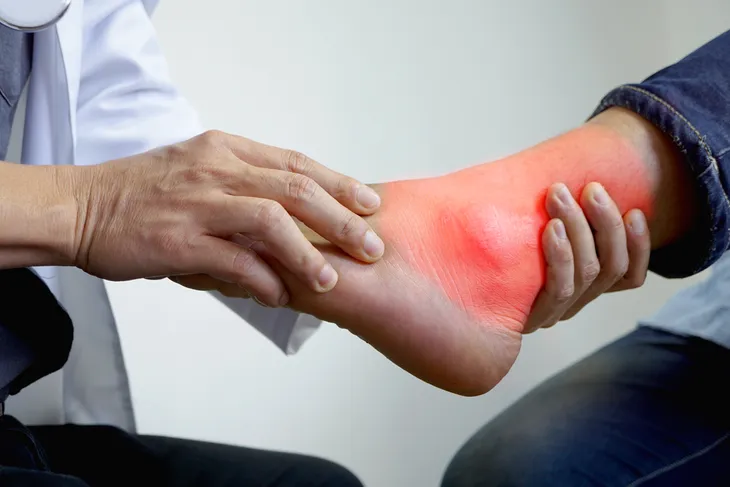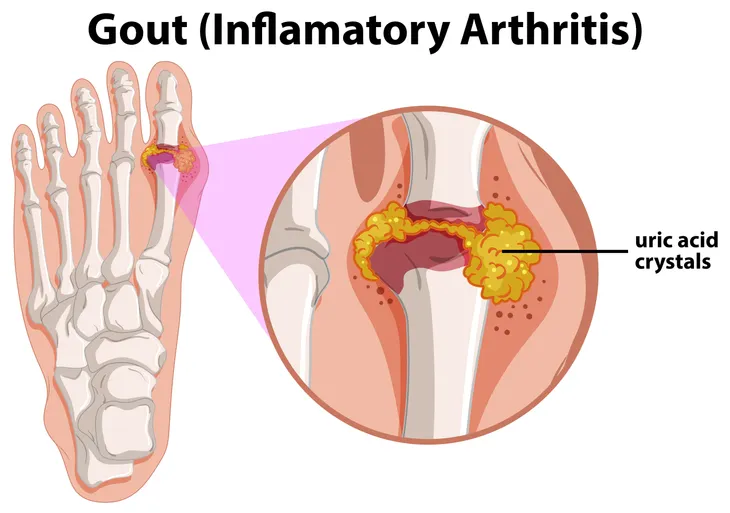Gout is one of the most painful forms of inflammatory arthritis. The attacks usually come without any warning and can feel like agonizing jolts of pain in the joint areas, usually beginning with the big toe.
There is currently no cure for gout at this stage, but the available treatments have incredibly efficient results. Despite this, many people will try to deal with their gout conditions in a DIY manner which can waste valuable time to get this terrible affliction under control. Here are 12 important facts you need to know about gout.
What to Do if You Think You Have Gout
If you’re a gout sufferer, or you feel like you may be having similar symptoms, you should talk to your doctor immediately to get ahead of this problem. With gout, the sooner you attack the symptoms head-on, the better your chances of leading a good quality lifestyle.
Gout Is Not Easily Diagnosed
As we know, getting a proper diagnosis of gout is essential to ensure that you are given the appropriate treatments and medications for your condition. You don’t want to make things worse by unnecessarily taking the wrong medications for an extended period of time. Unfortunately, gout is not easily diagnosed.
Gout is far from the only type of illness that causes joint pain and swelling. This is why it can be difficult to diagnose. Fortunately, doctors will immediately suspect gout if the patient suffers severe joint pain, followed by an asymptomatic period yet has persistent hyperuricemia.
Doctors Examine Synovial Fluid in Your Joint to Confirm Gout
One of the best ways to confirm the existence of gout in a patient is to closely take a look at the fluid lining of the affected joint. This fluid is called synovial fluid which doctors can examine closely under a microscope when they look for urate crystals.
Synovial fluid is extracted from inside the joint in small amounts via the use of a needle and syringe. In more advanced cases of gout, tophi, which is a deposit of crystalline uric acid that forms underneath the skin, can also be sampled.
In some cases, extracting synovial fluid may not be possible. In these situations, doctors will have to rely on performing physical exams, making visual observations, and running blood tests.
Gout Is Not Just About Arthritis Pain
Most gout flare treatments are focused on relieving the pain, swelling, and the resulting disability as quickly as possible. The problem is that many people only treat their gout condition whenever the symptoms are triggered.
Once the symptoms finally subside through medication, dietary changes, and/or physical activity, people often revert to their old ways. And then, of course, the cycle begins anew! Gout is not just about arthritis pain and it should be managed all the time not only when symptoms arise.
Leaving Gout Untreated Can Lead To Serious Complications
Gout is a serious condition that gets increasingly dangerous over time unless you give it the priority treatment it deserves. We know, for example, that elevated levels of uric acid in the body are directly linked with gout flare-ups, heart attacks, and strokes.
Since people who suffer from gout tend to be a little older and heavier, they are often at a higher risk of having high blood pressure and diabetes. As if that weren’t enough, prolonged suffering of gout pain throughout the years can lead to permanent joint damage and even deformation.
The fact is that there is no magic pill for curing gout. The best way to control your gout symptoms long-term is to follow your doctor’s lifestyle and dietary recommendations.
Yes, Women Can Get Gout Too
The fact that men typically have higher levels of uric acid for most of their lives than women do, makes them three times more likely to suffer from gout. However, cases of gout worldwide are on the rise and more women are being diagnosed with gout.
Women Are More Likely to Develop Gout After Menopause
Women are more at risk for developing gout after menopause due to decreased estrogen. This is because estrogen provides protection against gout and since the ovaries tend to produce less estrogen when menopause hits, the risk of gout increases considerably.
Although many healthcare professionals claim that hormone replacement therapy may help flush out excessive levels of uric acid in women, the studies and results are still up for debate.
Women are usually affected by menopause between their 40s and 50s. Women who develop gout at that age also tend to have other health conditions such as high blood pressure, diabetes, obesity, and kidney disease.
Being Overweight Is One of the Greatest Risk Factors for Gout
It is a well-known fact that weight gain and obesity are some of the greatest risk factors for developing gout. That’s why doctors usually recommend their patients participate in regular physical activity and eat a healthy diet.
Regular exercise is essential to maintaining a healthy weight which can cut down your risks of gout and heart disease. When you combine exercise with a healthy diet rich in fruits, vegetables, and whole grains, your risk of developing gout attacks is reduced even more so.
Weight Loss Helps, but Don’t Overdo It!
Unfortunately, the suffering and trauma caused by severe gout flares can lead people to take drastic actions to try to prevent these episodes from ever happening again. In some cases, this causes people to take their exercising to extreme limits in order to lose weight. Ironically, a rapid loss of weight can actually trigger gout attacks.
Therefore, the best approach is to modify your lifestyle and dietary routines gradually over the long term. When it comes to effective gout treatments, slow and steady wins the race!
High Levels of Uric Acid Cause Gout
Uric acid is basically a waste product and you should try to avoid having too much of it in your body, especially if you have gout. This is because too much uric acid can cause gout.
So how does uric acid accumulate in the first place? It’s created when the body breaks down chemicals called purines and eating purine-rich foods, such as red meats and certain seafood can lead to increased levels of uric acid in your body.
You Need to Know Your Uric Acid Level
It’s one thing to know what kind of foods and activities are more likely to contribute to a gout flare. It’s quite another thing when you know how much uric acid is acceptable to your body type.
If you can manage to check your own uric acid levels and keep an eye on how your gout condition is doing, your chances of avoiding a flare-up increase significantly.
What Are Normal Uric Acid Levels?
Normal uric acid levels for males are between 2.5 to 7.0-milligrams per deciliter (mg/dL) while women normally have 1.5 to 6.0-mg/dl.
While you may not always have access to medical tests, there are some symptoms you can monitor to control your uric acid level. For example, swollen, painful, and tender joints are common signs that gout activity is being stirred up.
When you notice similar symptoms, it may be a good idea to see your doctor and maybe get a uric acid test to confirm the symptoms.















